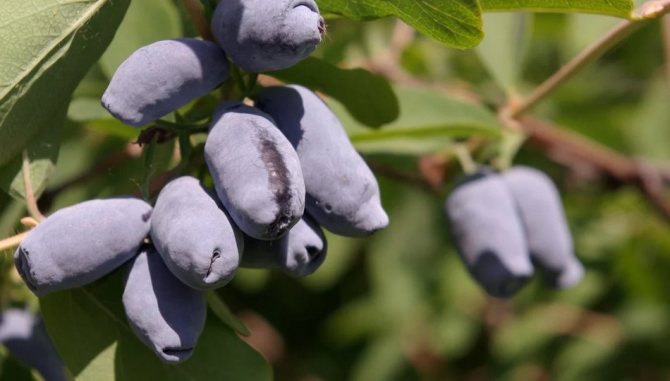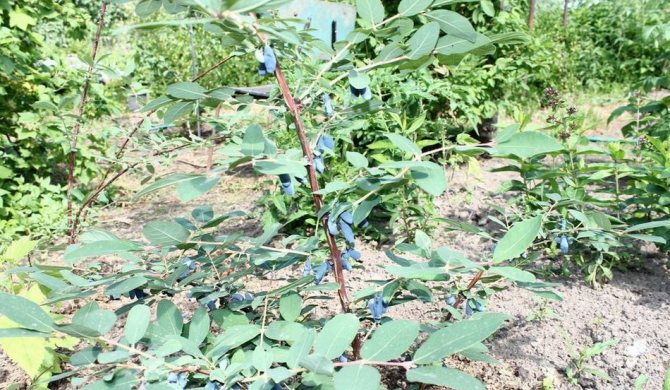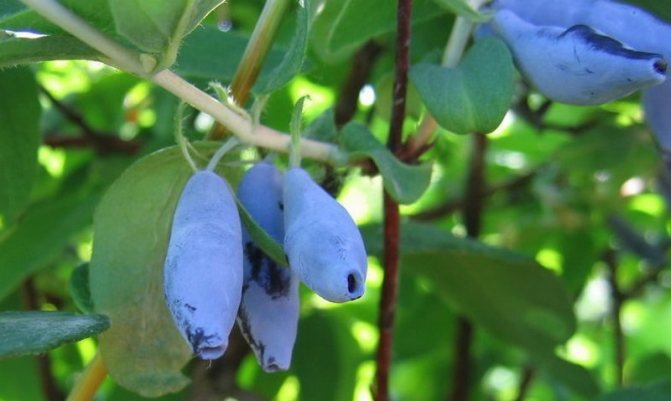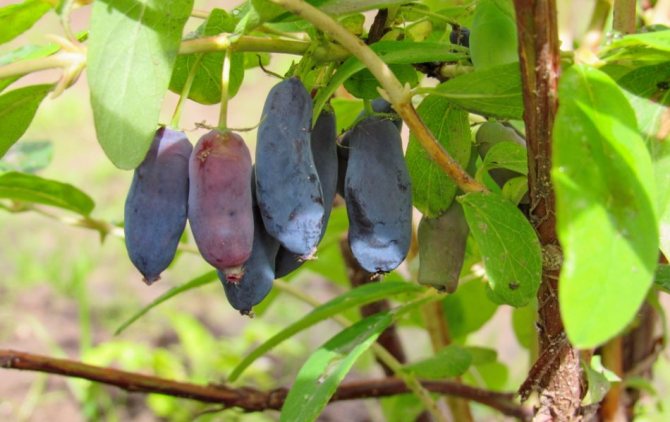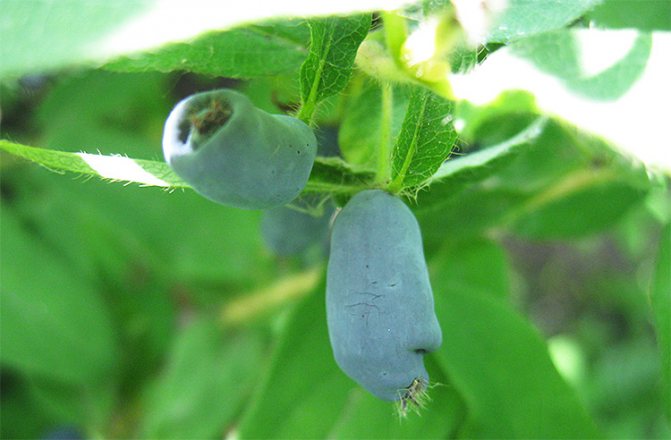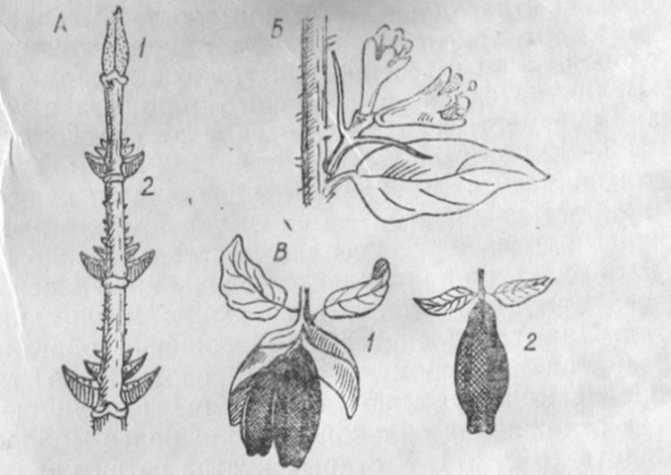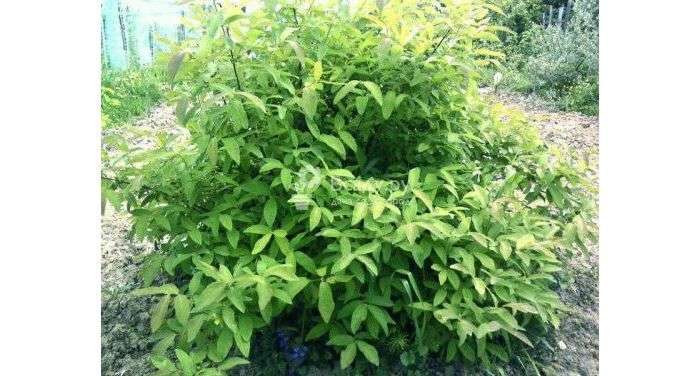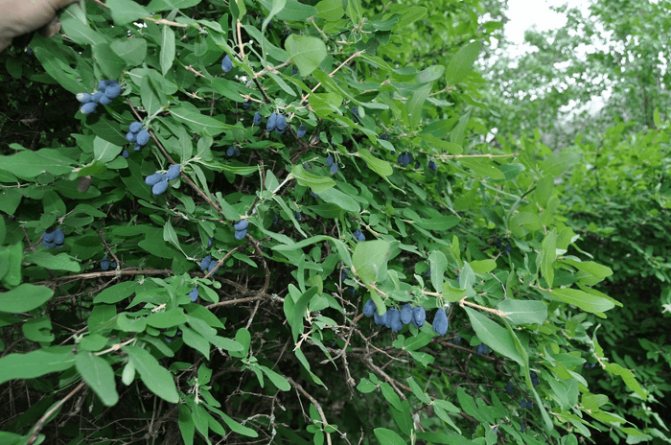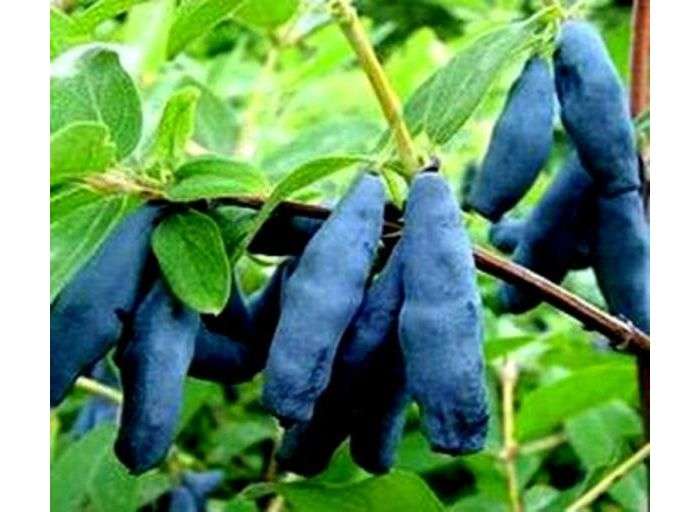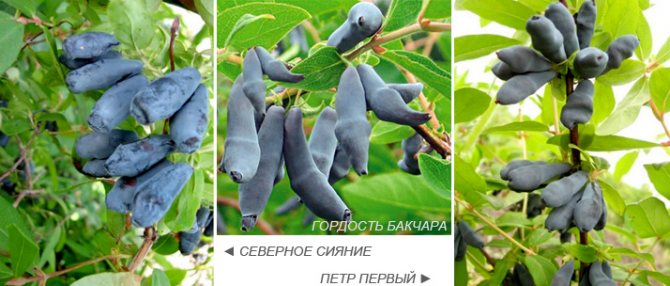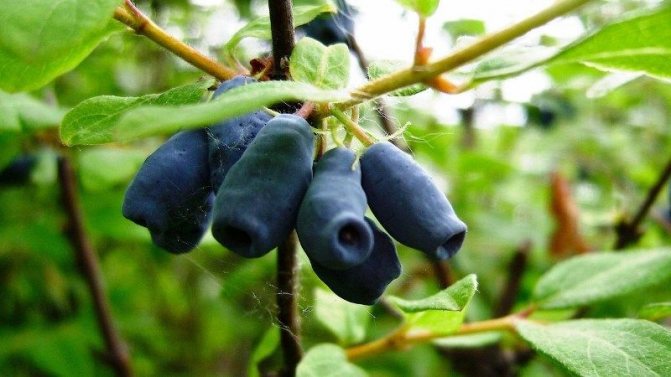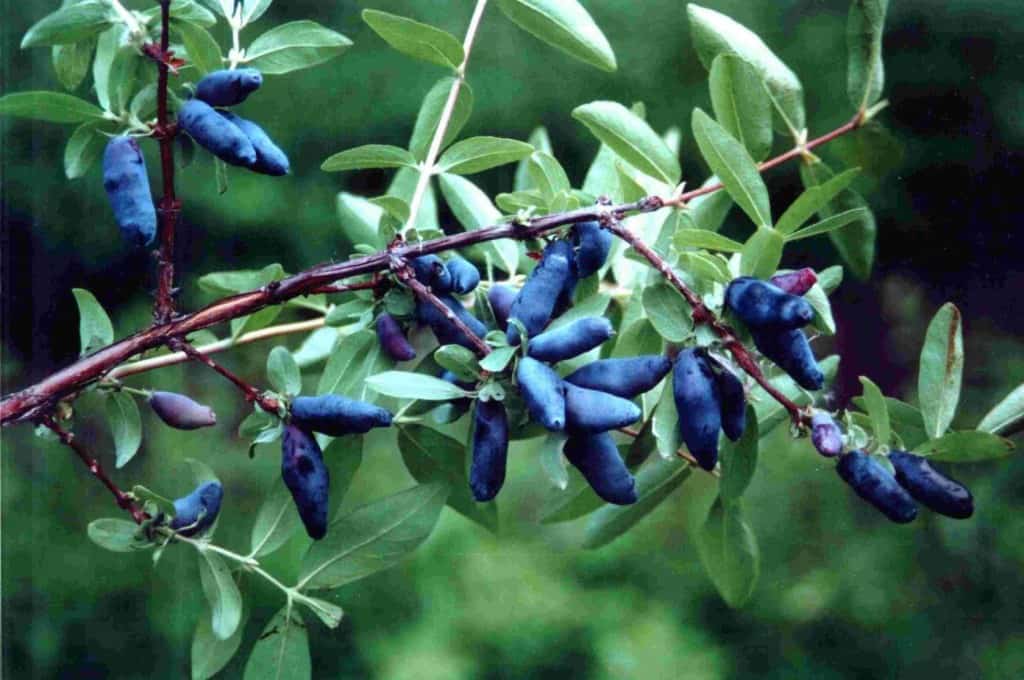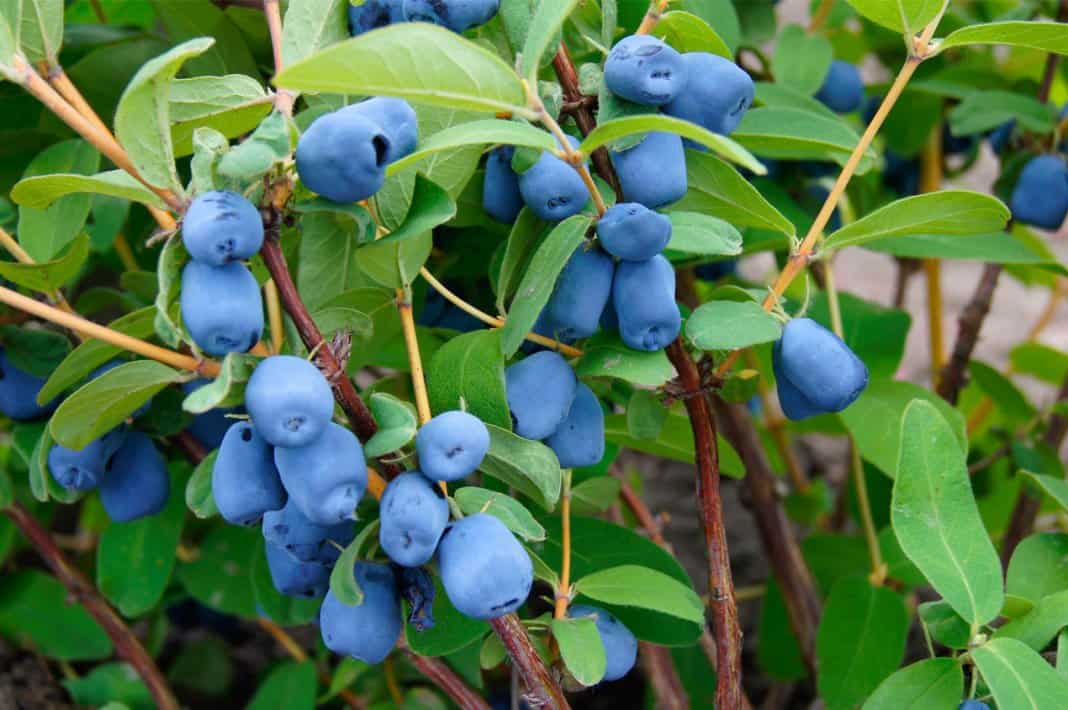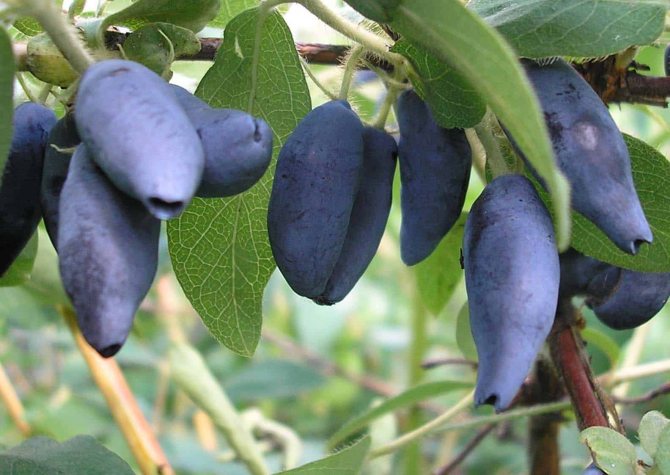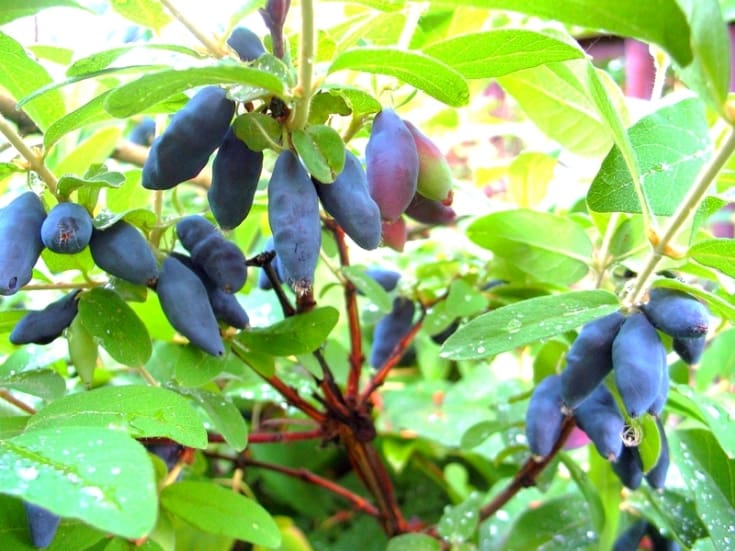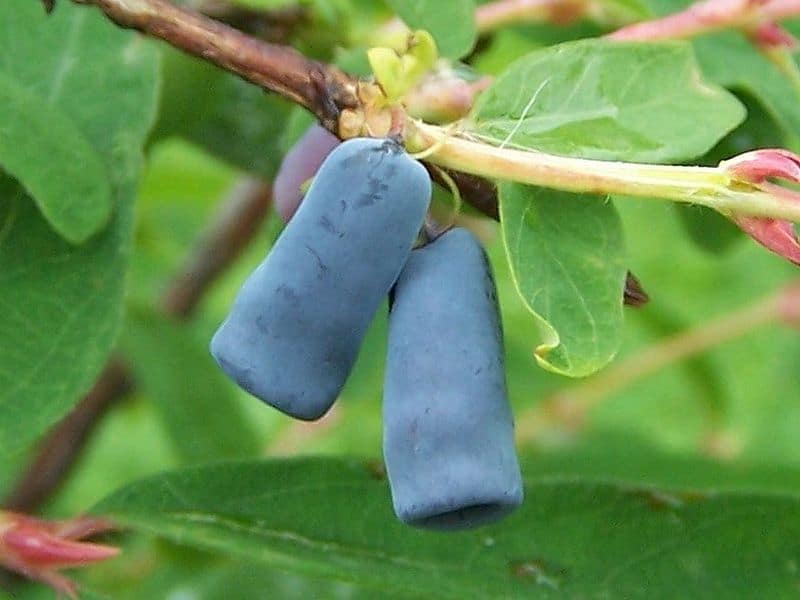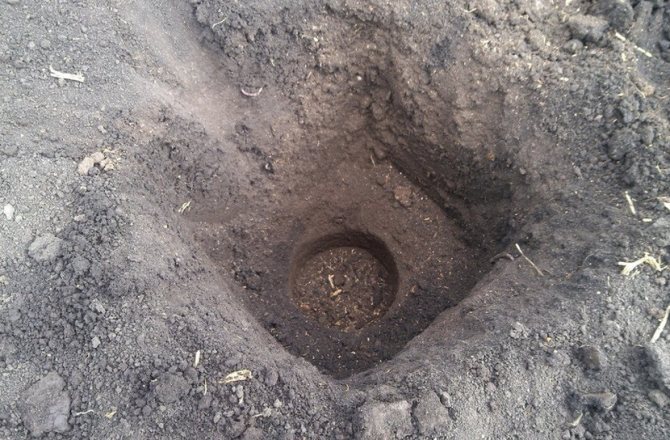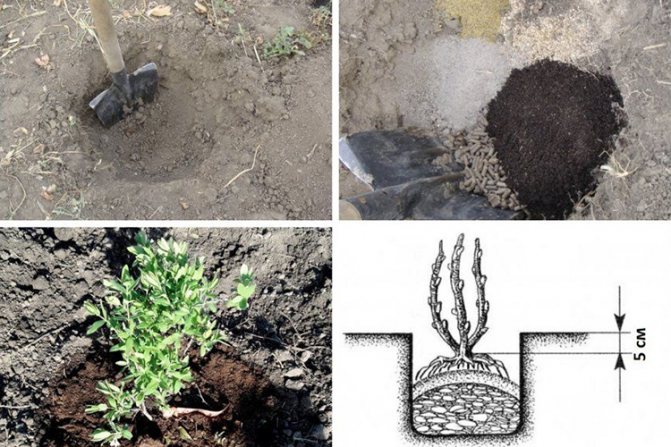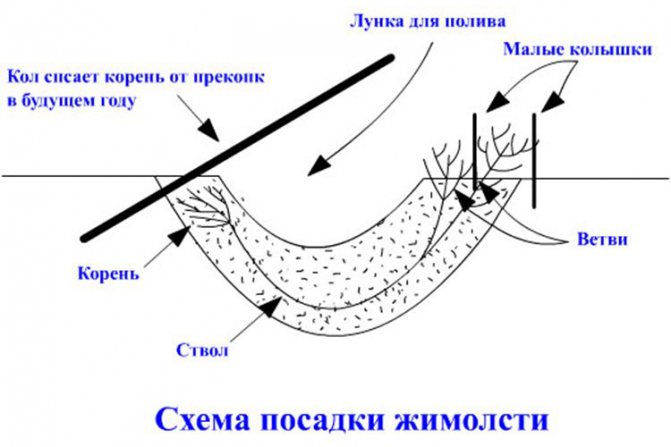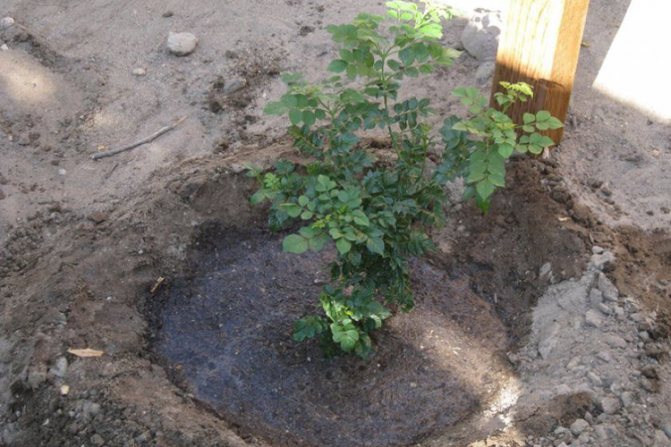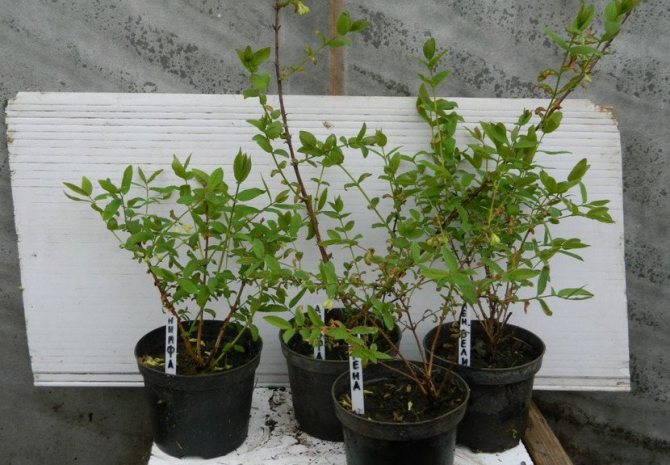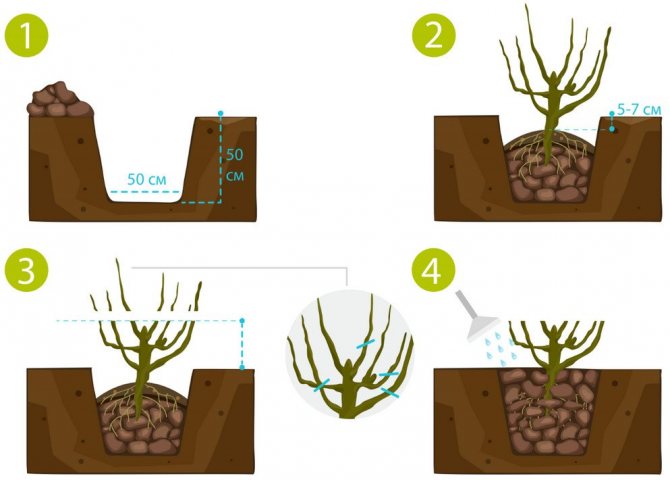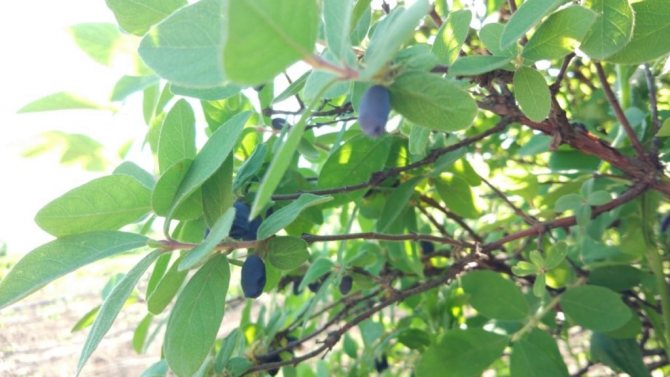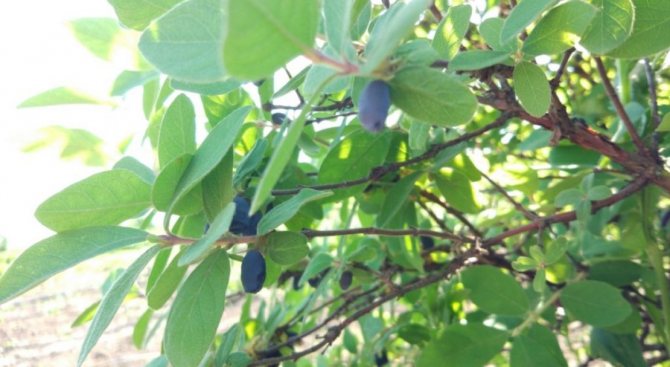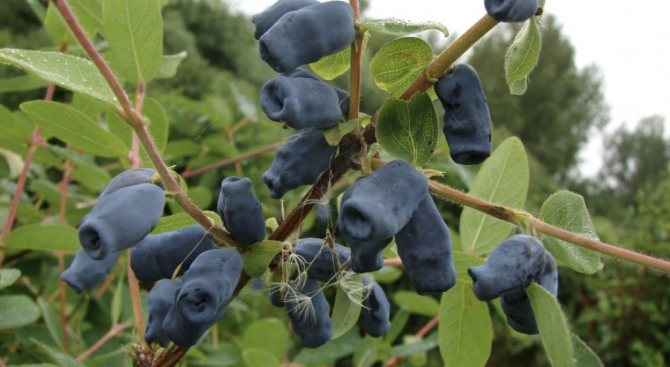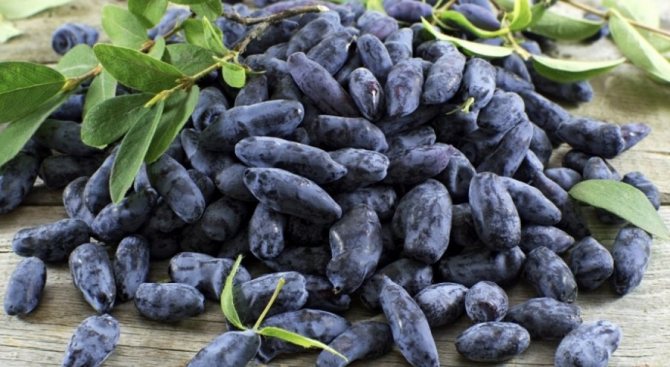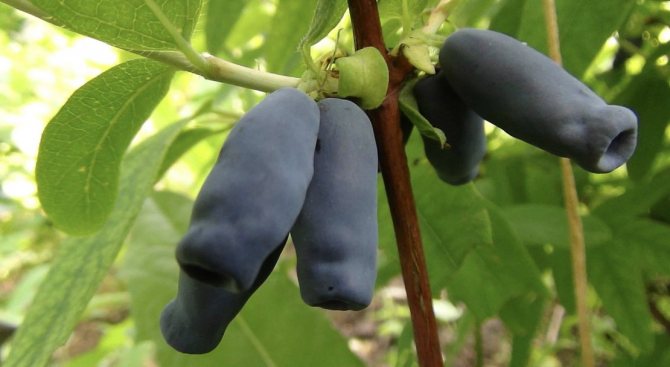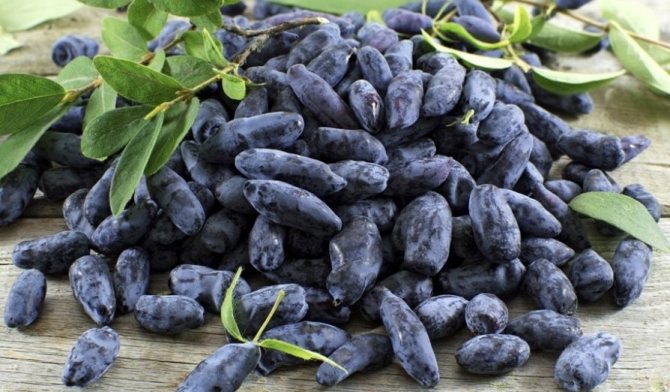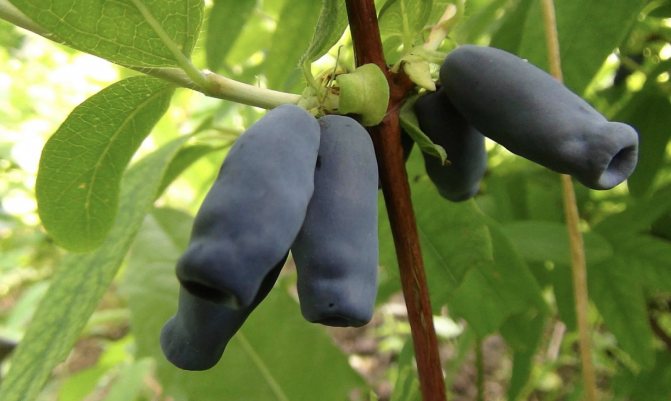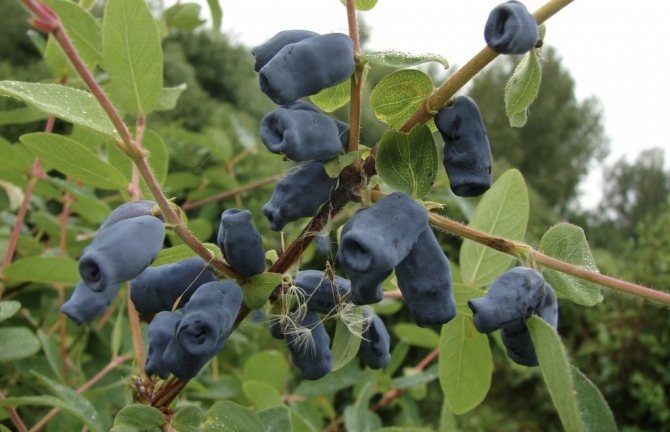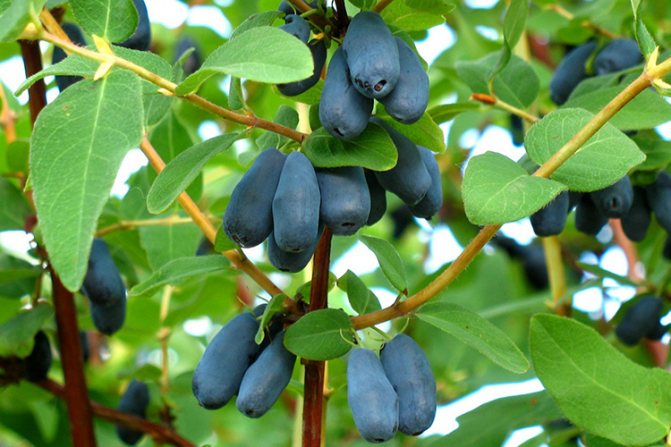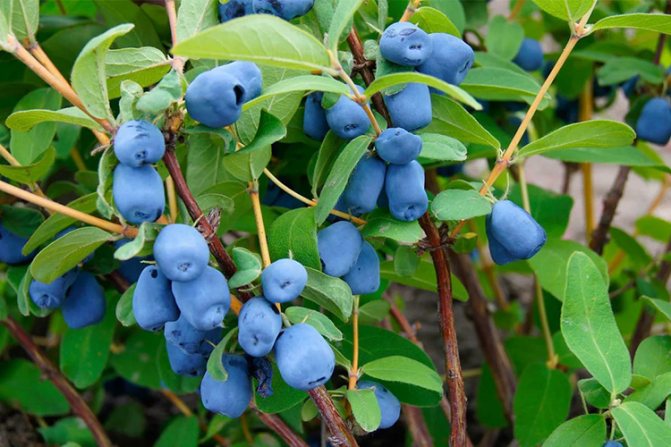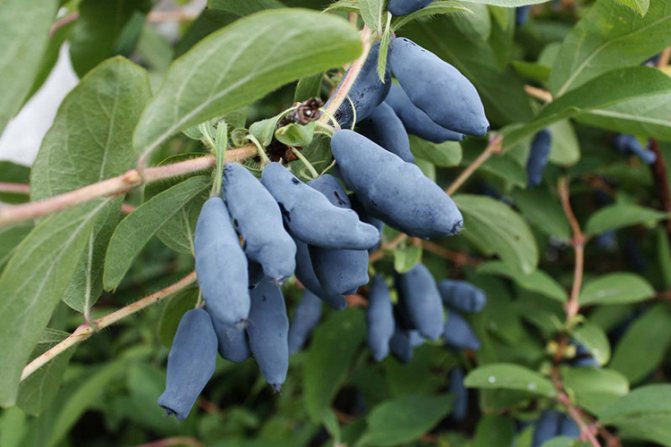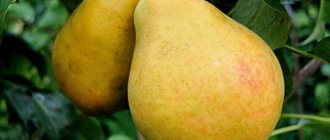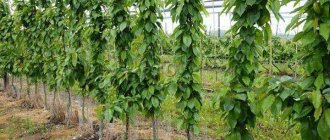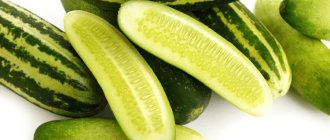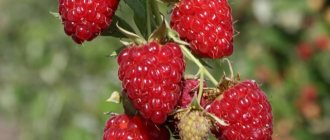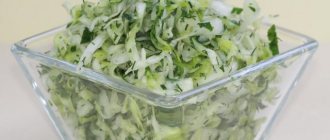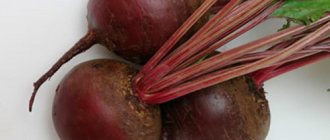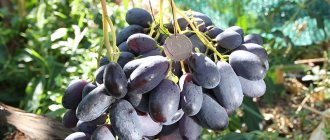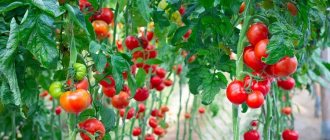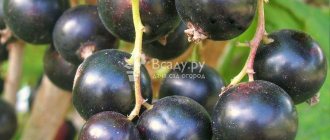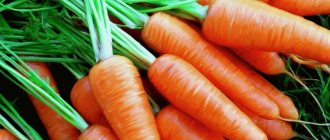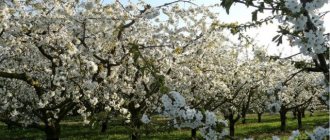Amphora
"Amphora" is a mid-late variety obtained at the Pavlovsk Experimental Station of the V.I. N.I. Vavilova (St. Petersburg). The wild-growing Kamchatka Honeysuckle and the Roxana variety were taken as a basis.
The variety was entered into the State Register in 1998. Suitable for growing in cold regions of our country.
The height of erect bushes is average - about 1.5 m. The rounded crown is dense and compact. Straight reddish-brown skeletal branches are rather thick. The decorativeness of these plants allows them to be successfully used in the landscape design of the site.
Fruits are large: length - 2 cm, weight - from 1.2 to 3 g. Shape - elongated jug-like. The surface is almost smooth. The bluish blue skin is firm and thick. There is a strong waxy coating on its surface. The taste of dense cartilaginous flesh is sweet and sour with a slight bitterness and lingonberry aftertaste. The tasting score on a five-point scale is 4.5.
Berries contain 13.8% dry matter, 7.6% sugars, 2.6% acids. Ascorbic acid is present in an amount of 58 mg per 100 g.
The variety is well suited for making jams, compotes, juices. The crop is characterized by good transportability.
Is honeysuckle suitable for the Moscow region
Honeysuckle is an unpretentious frost-resistant shrub that opens the berry season earlier than others. The culture is successfully grown by gardeners from all regions of Russia, including the Moscow region. The climate of the middle lane is ideal for many varieties.
The fruits ripen on decorative and edible varieties of honeysuckle, however, the use of berries from the first can result in serious poisoning. Inedible varieties are easily distinguished by the size and color of the berries: they are small, most often red or yellow, but there are also bright blue and black. Only one type of shrub is edible - blue honeysuckle. The fruits of this variety are elongated, bluish-blue, covered with a waxy coating.
Site and soil requirements
Honeysuckle Blue bird belongs to unpretentious crops. However, in order for it to develop normally and bring a high-quality bountiful harvest, you must use the following recommendations:
- Honeysuckle thrives in loose soil with medium acidity. Ordinary black soil is perfect for planting. Loam and sandy soils are also acceptable. If on the site there is land with an increased level of acidity, then liming is preliminarily performed.
- The blue bird (like other varieties of this plant) does not tolerate prolonged stagnation of water. In this case, the earth around it should be constantly moderately moist. It is not recommended to plant in lowlands or in soils with a high level of groundwater, since this position is fraught with root rot.
- The "permanent residence" of the culture should be well lit, otherwise the lack of sun will affect the quality of the fruit. You should also choose an area protected from northerly winds. Other plants can be planted around as a protective barrier.
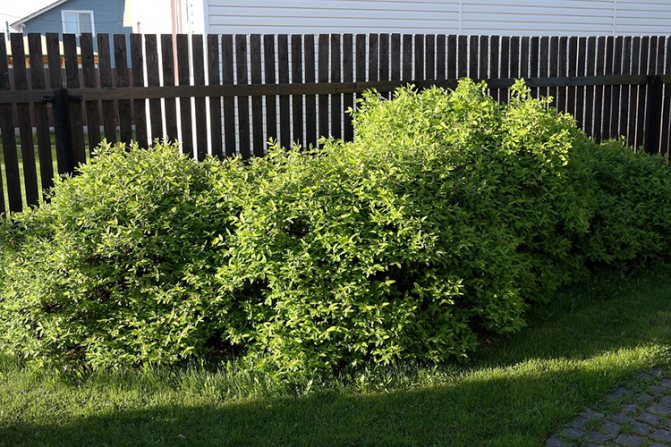
Bakchar giant
A mid-season large-fruited variety of honeysuckle, obtained by breeders from the Federal State Unitary Enterprise "Bakcharskoe" (Tomsk region). Suitable for growing in various regions of the Russian Federation.
Tall, powerful bushes with an oval spreading crown reach a height of 170-190 cm and a width of 130 cm.Skeletal branches are thick, straight.
The large honeysuckle berries of this variety are slightly asymmetrical. The shape is elongated oval. The surface is slightly bumpy with a strong waxy bloom. The scar is dry. The average weight of each fruit is about 1.8 g, some specimens are up to 2.5 g. The length is from 4 to 5 cm. The diameter is 1.2 cm. The taste of the pulp is sweet and sour, delicate.
The dark blue skin is of medium thickness. Delicate pulp tastes sweet and sour. Tasting score - 4.8 points.
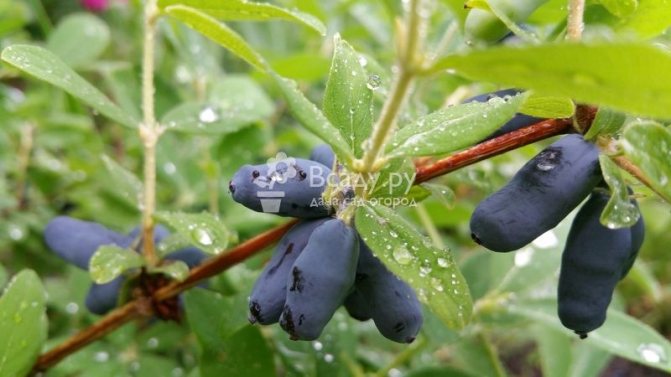

Berries can be eaten fresh, frozen for the winter, processed into jams, compotes, juices, and wines. The crop is suitable for transportation.
Edible honeysuckle varieties for the middle lane
For plots in the Moscow region and neighboring regions, many varieties of honeysuckle edible for the middle lane are suitable. Often they choose those with sweet fruits that stick tightly to the branches.
Sweetheart
In the conditions of the Moscow region, it ripens by mid-June, frost-resistant, does not get sick. The berries are small, 1.6 g, with a fragrant sweet and sour pulp, where 13.3% sugar is determined.
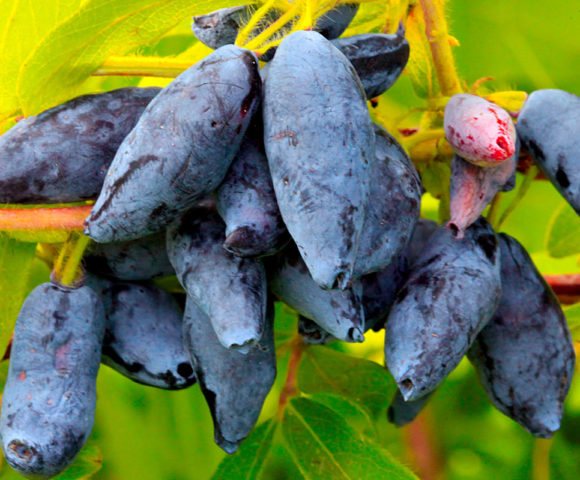

Slastena was recently bred in Kamchatka
Fortune
In the early ripening variety Fortuna, sourness is combined with pleasant sweetness, the berries do not crumble. Weigh 70-90 mg, tender dessert pulp. 2.4 kg are harvested from the bush.
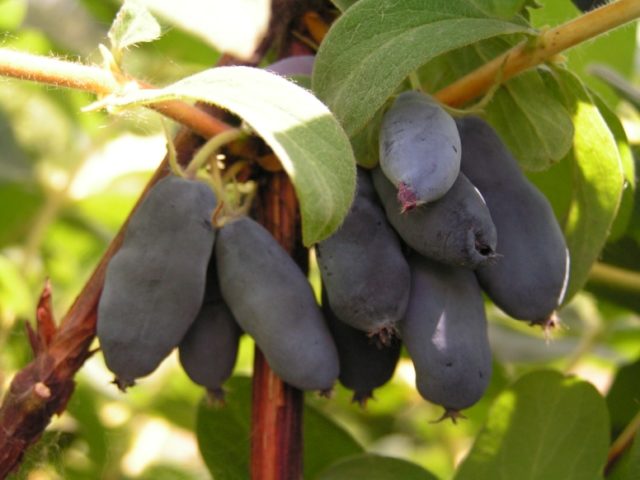

Fortune is the result of the work of scientists of the N.V. Tsitsin Botanical Garden in Moscow
Long-fruited
On a spreading crown, large berries ripen from early or mid-June. Weigh up to 2 g, size 3 cm. Productivity 2.7-3.1 kg, weak shedding. The harmonious taste combines sugariness and invigorating sourness, without bitterness.
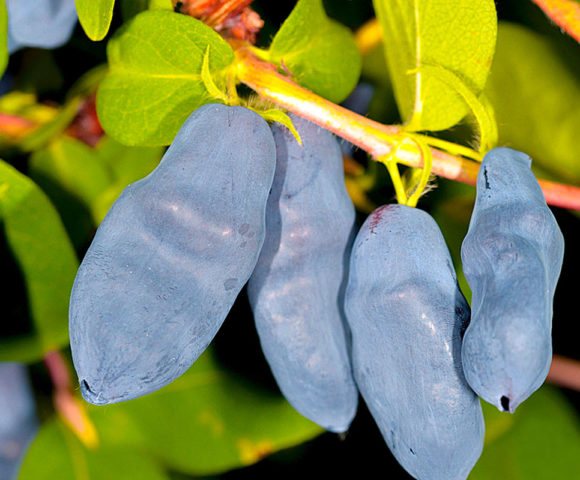

Long-fruited honeysuckle has amicable maturation
How to plant: nuances and step by step instructions
Choosing the right place for planting honeysuckle is an important condition for obtaining a large harvest. The plant needs to select a sunny, heated area. Some shading is acceptable, preferably in the afternoon.
Honeysuckle prefers slightly moist, light soil. Nearby groundwater and acidity can be detrimental to the plant.
For planting, it is preferable to choose young plants at the age of 2-3 years. The optimal planting time depends on the type of root system:
- for open - from late August to mid-September;
- for a closed one - from early spring, when the soil warms up to at least 12 degrees, until the beginning of autumn.
Planting technology consists of the following stages:
- The site is dug into 2 bayonets of a shovel, then planting holes with a diameter and depth of 50 cm are prepared.
- Drainage is laid at the bottom with a layer height of 10-15 cm.
- The soil from the pit is supplemented with sand, humus and ash in equal amounts.
- A pile of prepared soil mixture is poured onto the drainage, a seedling is placed on it, spreading the roots. The root collar should be 5–7 cm above the surface.
- A number of support is installed next to the seedling.
- The soil is watered abundantly, then mulched with dry foliage or straw.
The choice of planting material
For planting honeysuckle, it is best to use seedlings 2 years old. They should be bought in special nurseries that have documentation with a description of the variety. Or make planting material yourself using an existing bush. Otherwise, there is a risk of growing not the Bluebird, but a completely different plant. It is important to remember that there are a lot of varieties of honeysuckle and among them there are a sufficient number of unsuitable species for food.
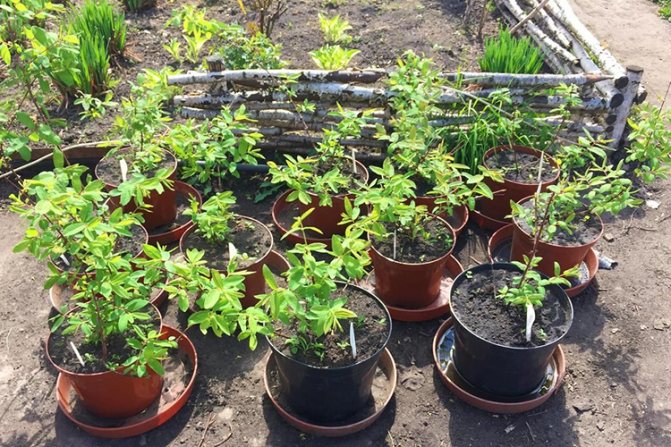

When buying a seedling, it must meet the following parameters:
- height - 30-50 cm;
- age - 2-2.5 years;
- well-developed closed root system;
- no visible defects.
Preference should be given to seedlings grown in the region where it will be planted. And do not take him from afar. At the same time, it will be better adapted to local conditions and will well tolerate transplanting into the ground for a "permanent residence".
Cinderella
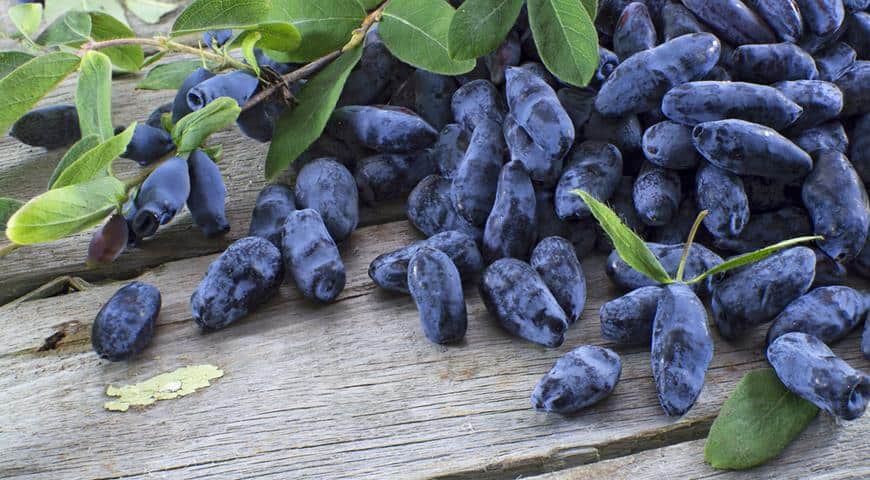

A mid-early variety, bred by breeders of the Research Institute of Horticulture of Siberia named after I. M.A. Lisavenko in 1974. Currently included in the State Register of the Russian Federation for cultivation in all regions.
The height of low-growing bushes does not exceed 70 cm. The crown is compact, dense. Elongated-oval, weakly concave large leaves are light green in color.
Elongated cylindrical berries are medium in size. Their mass is from 0.7 to 1.4 g, length is up to 1.7 cm. Thin dark blue skin is covered with a delicate blue bloom. The taste is sweet and sour with a delicate strawberry aroma. The tasting score is close to the highest - 4.8 points. The pulp contains in its composition from 8.4 to 8.7% of sugars and from 1 to 1.4% of acids. The content of vitamin C is about 20 mg per 100 g, vitamin P - up to 599 mg per 100 g. The share of pectin substances is up to 1.12%.
The appointment is universal.
How to care
The first years after planting are the most crucial period for caring for honeysuckle. While the young plant is gaining strength and preparing for fruiting, maximum attention is paid to it. The size of the crop directly depends on this.
Watering and feeding
Despite the resistance of honeysuckle to drought, the shrub needs a sufficient amount of moisture for active growth. A young plant is watered daily on hot summer days, with the exception of rainy weather. 10 liters of water are consumed per bush, in especially dry and hot periods - 20 liters.
Top dressing under the root of a young plant is applied twice a year:
- in the spring, before the buds swell - ammonium nitrate (15 g per 1 sq. m);
- in the fall - 40 g of superphosphate and 100 g of wood ash per 5 kg of compost.
If the bush is lagging behind in growth, an extraordinary feeding with mullein infusion is carried out. Half a bucket of fresh manure is poured with water and infused for 7-10 days. Before use, a liter of infusion is diluted in a bucket of water and 5 liters are consumed per plant.
To ensure air access to the roots, the soil under the shrub is regularly, but with the utmost care, loosened. In the spring, after the snow melts, the bushes spud and the soil surface is mulched abundantly.
Formative pruning begins in the fifth year after planting. The procedure is performed in early spring, before the development of the kidneys. Remove old, withered shoots, as well as branches with signs of disease. If the bush is too thick, cut out shoots coming directly from the soil.
Preparing for winter
In the Moscow region, honeysuckle winters well without shelter, but if very severe frosts are expected, you can cover the tree trunk circle with spruce branches or cover it with straw. The main measures for preparing for the cold are water-charging irrigation, if the weather is dry, and digging the soil under the bush.
Preparing for winter
Honeysuckle is frost-resistant and does not require special shelter in winter, however, to prepare the plant for the cold, the following steps should be taken:
- In autumn, remove mulch and fallen leaves under the bush.
- Dig the soil in the trunk circle to a depth of 15–20 cm and apply seasonal fertilizers.
- Tie the thin branches together to avoid damage from large amounts of snow.
- Cover the honeysuckle bushes with burlap as protection from birds.
Did you know? In total, there are about 250 types of honeysuckle in nature. Moreover, the berries of most species are inedible, and some are even poisonous.
Darling
This late-ripening frost-resistant fruitful variety was included in the State Register of the Russian Federation in 2001. Originator - Zoya Ivanovna Tselykovskaya.
Slightly squat bush. Brownish, slightly pubescent shoots moderately curved. Inflorescence is 2-3 flowers. The flowers are large.
The average mass of elongated berries with a pointed tip is about 1.2 g. The length is about 2 cm. The color of the thin skin is dark blue. There is a gray waxy coating on the surface. Delicate pulp tastes sweet and sour. Tasting score - 4.9 points.
This variety is characterized by a pairwise fusion of berries.
Growing problems and their solution
Honeysuckle is resistant to diseases and pests, but if the rules for caring for the plant are violated, some problems are possible:
- Powdery mildew. The disease affects overly dense bushes in damp, cold weather. For prophylaxis, plants are treated with the drugs "Forecast", "Topaz", "Fundazol".
- Ramulariasis, or white spot. Fungal disease, the spores of which form drying spots on the leaves. With a large infection, the number of berries is halved. All parts of the plant showing signs of infection are cut off and burned. The bush is treated with Bordeaux liquid or any fungicidal preparation.
- Cercosporosis. Too dense bushes are susceptible to the disease. Light brown spots with a red border, 3-4 mm in diameter, appear on the leaves. Favorable conditions for the development of the fungus - an air temperature of 25 degrees Celsius in combination with high humidity. Preventive spraying with fungicides in early spring helps to fight the disease.
- The plant does not bear fruit well. The reason for the low yields is insufficient pollination of flowers. If 2-3 bushes of one or two varieties are planted on the site, you should not expect a large number of berries. For good fruit setting, it is necessary to plant at least three varieties that will pollinate each other. In order for the bushes to attract pollinating insects, they need to be arranged not in a row, but in a large clump.
- There are no signs of illness, but the bush withers and gradually dries up. The cause may be improper watering and damage to the roots when loosening. It is better to water the honeysuckle rarely, but abundantly, then the water will be evenly absorbed by the roots. Instead of frequent loosening, it is better to mulch the soil with a high layer, then after watering, a crust will not form on the surface.
Weak from lack of nutrients and improper care, honeysuckle bushes are often attacked by pests:
- honeysuckle aphid;
- leaflet;
- finger wing;
- shield;
- moth.
It is possible to spray the bushes with insecticidal preparations for the destruction of insects only after harvesting. During flowering and fruit formation, pests are harvested by hand or sprayed with an infusion of tobacco dust.
Altair
This early-ripening variety has already caught the fancy of many gardeners due to its resistance to cold, common diseases and pests. Delicious and sweet berries (blue-blue with a waxy coating) ripen on a bush with a dense and squat crown in mid-June and do not crumble for a long time. Therefore, Altair is great for people who come to the country no more than once a month. After all, even fully ripe berries remain on the plant until you pick them.
Moraine
"Morena" is an early-ripening variety of honeysuckle, bred at the Pavlovsk Experimental Station of the V.I. N.I. Vavilova (St. Petersburg). Included in the State Register with a note - for cultivation in all regions of Russia. This is one of the best varieties not only for the Moscow region, but also for the North-West.
The height of the bushes reaches 170 cm, the diameter is also up to 170 cm.The crown is squat oval. The decorativeness of these plants allows them to be effectively used in landscaping the site.
The length of one-dimensional elongated jug-shaped fruits ranges from 2.5 to 3 cm, diameter - up to 1.1 cm, weight - from 1 to 1.3 g (individual berries - up to 3.5 g). The skin is thin, translucent. The slightly bumpy surface is covered with a strong waxy coating. The color is blue-blue. Taste - sweet and sour without bitterness. The pulp is soft and tender. Tasting score - 4.5 points.
The fruits contain 13.6% dry matter, 7.8% sugars, 2.3% acids. The proportion of ascorbic acid is 54 mg per 100 g.
The appointment is universal. Transportability is good.
Testimonials
Vitalina Mikhailovna, Rostov-on-Don: I love the Blue Bird honeysuckle variety. The description of its main properties corresponds to reality. In fact, the shrub has taken root well and does not take much time for itself. And the berries have all the most positive reviews.
Evgeny Ivanov, Nizhny Novgorod: Honeysuckle The blue bird is the very first to ripen in our garden. It is a tall, frost-hardy shrub with good disease resistance. But, ripe berries crumble even with a light wind. They, of course, can be found in the grass and there they are well preserved, but this is very inconvenient.
Margarita Ilyina, Ufa:. I have been growing the Blue Bird variety in my country house since the mid-90s. Wonderful berry bush. A source of vitamins. It is well pollinated by Cinderella, but you can choose any other appropriate pollinator variety. The fruits, if not eaten by everyone, are frozen, ground with sugar.
Reproduction methods
It is possible to grow honeysuckle independently from seeds, but in this case it is not worth hoping for the preservation of the varietal characteristics of the mother plant. Most likely, you get a decorative look with small, tasteless berries.
You can get a full-fledged bush with a vegetative propagation method:
- Division of the bush. To do this, use a bush no more than five years old. The plant is dug up, cut into several parts and planted in prepared pits at a distance of at least 3 meters from each other.
- Cuttings. Semi-lignified or green shoots with two or three buds and two internodes are used. An oblique cut is made under the lower kidney and the cutting is placed in water with the addition of a root formation stimulator. After the roots appear, the shoot is planted in a pot filled with a loose soil substrate. The optimal time for harvesting cuttings is from the beginning of ripening of berries until the end of summer.
- Rooting of layers. In the spring, they choose the lower one-year-old shoot, bend it to the soil and fix it with a slingshot made of wood or wire. Sprinkle with soil on top and watered. The rooted shoot is separated for growing as an independent plant the next year, after wintering.
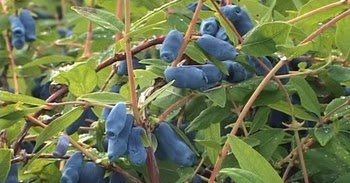

Honeysuckle is gaining more and more popularity among amateur gardeners in the Moscow region. This plant is perfectly adapted to the climate of the middle zone and pleases the owners of suburban areas with excellent flowering and delicious berries with minimal maintenance.
Shrub Best for you
Increasingly, a new shrub appears in the gardens of our fellow countrymen - edible honeysuckle. It resembles blueberries to some, blueberries to others, but this is completely different. At the same time, it is no less interesting, healthy and tasty. Honeysuckle berries can be eaten fresh, preserved, frozen. It is versatile and, importantly, unpretentious in care. Therefore, anyone who previously found it difficult to grow blueberries should definitely look in the direction of honeysuckle. And our rating of the best varieties of 2020 will show you the most promising seedlings of this shrub. We meet the best berries of edible honeysuckle, which should grow in every garden, along with currants and gooseberries.
Nymph
A mid-early variety of honeysuckle from the Pavlovsk Experimental Station of the V.I. N.I. Vavilov, included in the State Register of the Russian Federation in 1998.
The dimensions of the bushes are 1.5 by 1.7 m. The crown is rounded, slightly spreading. Brownish-green pubescent shoots are thick and long.
Elongated fusiform bluish-blue berries are large in size. Their mass ranges from 1.16 g to 3 g. Diameter - 9 mm, length - up to 30 mm. The surface is very hilly. The thin, dense skin is covered with a medium-intensity waxy bloom. The fibrous pulp has a moderately tart sweet-sour taste with a slight bitterness and a pronounced spicy aroma. Tasting score - 4.8 points.
Chemical composition: dry matter (14.3%), sugars (8.8%), acids (2.1%), ascorbic acid (54 mg per 100 g).
The use is universal.
Siberian
An early ripe frost-resistant self-fruitless variety obtained by the staff of the Bakcharsky support point (Tomsk region) in 1972 as a result of crossing of Kamchatka Honeysuckle and Turchaninov's Honeysuckle. The variety was entered into the State Register in 2000. Tolerance - all regions.
Medium spreading bushes reach a height of about 160 cm. The shape of the crown is hemispherical. Skeletal branches are of medium thickness.
Dark purple fruits are large, sweet, aromatic. The wax coating on the surface is weak. The mass of fusiform, slightly curved berries is from 1.1 to 1.4 g, the length is from 2 to 2.5 cm. The pulp is tender and juicy. The taste is great. Tasting score - 4.9 points. Chemical composition: sugars (8.2%), acids (1.9%), vitamin C (32 mg per 100 g).
The appointment is universal. Transportability is average.
Blue bird
An early ripe winter-hardy variety from the Siberian Research Institute of Horticulture, obtained on the basis of Kamchatka Honeysuckle.
The height of massive bushes is from 130 to 180 cm. The dense spreading crown has an oval shape. Shoots are thin, not pubescent.
Length of oblong-elliptical blue-blue berries reaches 2 cm, weight - from 0.75 to 1.2 g. The thin skin is covered with a strong waxy bloom. The delicate pulp has a mild sweet-sour slightly tart taste, reminiscent of wild blueberries.
Chemical composition: sugar (6.4%), vitamin C (17 mg per 100 g), vitamin P (631 mg per 100 g).
The application is universal.

